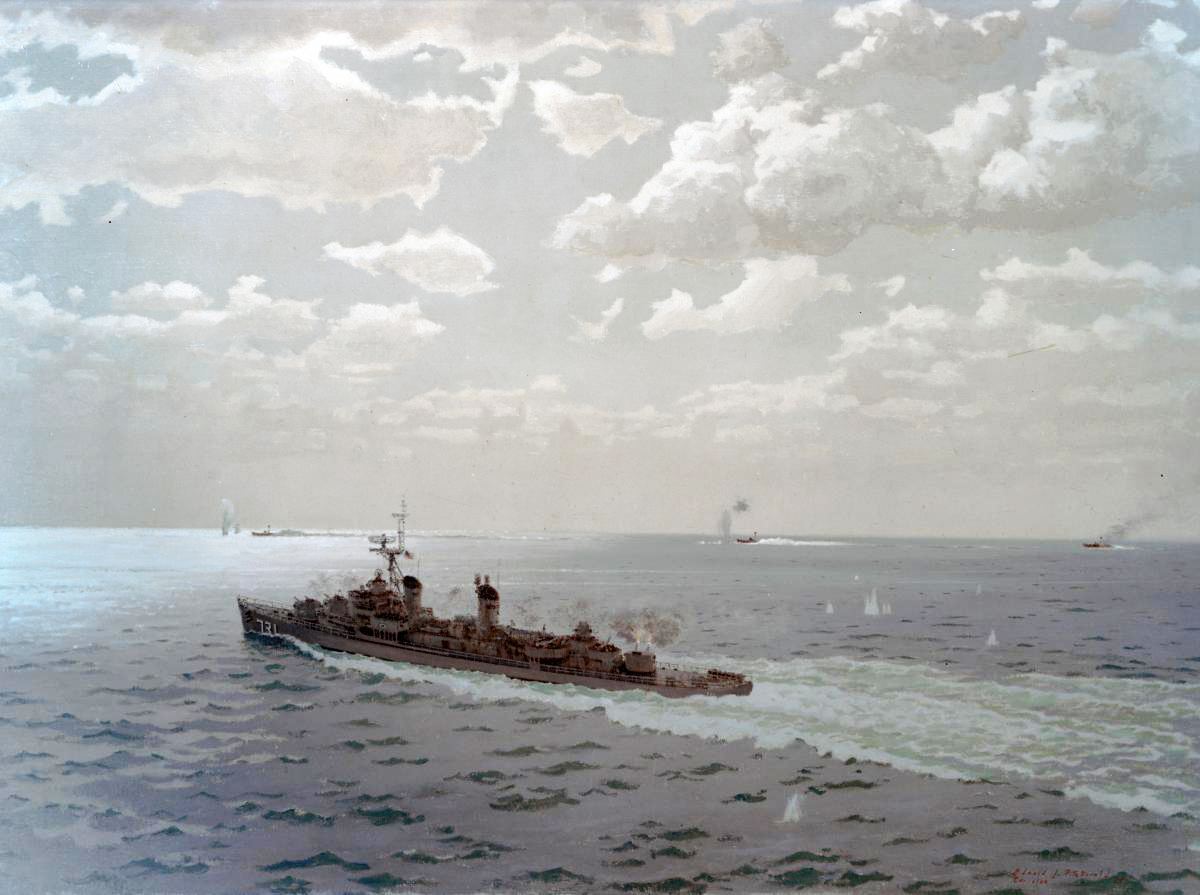
The Gulf of Tonkin Incident on August 02 - 04 1964
The Gulf of Tonkin Incident: One real and one phantom firefight embroiled the United States in the Vietnam War.
After World War II, France reoccupied its former colonies in Southeast Asia, only to be kicked out again by the forces of Communist leader Ho Chi Minh. In 1954, as the conflict wound down, the world’s powers reached an agreement to temporarily divide Vietnam in two, with all Ho supporters going north and all French supporters going south. Elections were supposed to reunite the country within a couple of years, but the United States opposed them over concerns that Ho would win the presidency. Instead, it propped up the corrupt and authoritarian government of Ngo Dinh Diem. South Vietnam “was essentially the creation of the United States”, the Defense Department would later admit in the Pentagon Papers. Within a few years, a rebellion had sprung up against Diem, aided by Ho’s forces in the north, who oversaw a string of assassinations against non-Communist village leaders.
Under presidents Harry S. Truman, Dwight D. Eisenhower, John F. Kennedy and Lyndon B. Johnson, the United States gave France - and then South Vietnam - economic aid and weapons with which to fight the Communist rebels. It also sent over more and more military advisors, some of whom participated in raids despite ostensibly being there only for self-defense. As part of one such covert operation, the United States trained and directed South Vietnamese sailors to bombard radar stations, bridges and other targets along the North Vietnamese coast. Meanwhile, U.S. warships such as the Maddox conducted electronic espionage missions in order to relay intelligence to South Vietnam. The rebels continued gaining ground, however, both before and after U.S. officials sanctioned a coup in which Diem was murdered.
At this point, U.S. involvement in Vietnam remained largely in the background. But in the pre-dawn hours of July 31, 1964, U.S.-backed patrol boats shelled two North Vietnamese islands in the Gulf of Tonkin, after which the Maddox headed to the area. As it cruised along on August 2, it found itself facing down three Soviet-built, North Vietnamese torpedo boats that had come out to chase it away. The Maddox fired first, issuing what the U.S. authorities described as warning shots. Undeterred, the three boats continued approaching and opened up with machine-gun and torpedo fire of their own. With the help of F-8 Crusader jets dispatched from a nearby aircraft carrier, the Maddox badly damaged at least one of the North Vietnamese boats while emerging completely unscathed, except for a single bullet that lodged in its superstructure.
The following day, the U.S. destroyer Turner Joy was sent to reinforce the Maddox, and U.S.-backed raids took place against two additional North Vietnamese defense positions. Then, on August 4, the Maddox and Turner Joy reported that they had been ambushed, with enemy boats firing 22 torpedoes at them. In response, President Johnson ordered air strikes against North Vietnamese boat bases and an oil storage depot. “Aggression by terror against the peaceful villagers of South Vietnam has now been joined by open aggression on the high seas against the United States of America”, he said that evening in a televised address. He also requested a congressional resolution, known as the Gulf of Tonkin Resolution, which on August 7 passed unanimously in the House and with only two dissenting votes in the Senate, essentially giving him the power to wage war in Southeast Asia as he saw fit.
Throughout these hectic few days, the Johnson administration asserted that the destroyers had been on routine patrol in international waters. In actuality, however, the destroyers were on an espionage mission in waters claimed by North Vietnam. The Johnson administration also described the two attacks as unprovoked; it never disclosed the covert U.S.-backed raids taking place.
Another problem: the second attack almost certainly never occurred. Instead, it’s believed that the crewmembers of the Maddox mistook their own sonar’s pings off the rudder for North Vietnamese torpedoes. In the confusion, the Maddox nearly even fired at the Turner Joy. Yet when U.S. intelligence officials presented the evidence to policy makers, they “deliberately” omitted most of the relevant communications intercepts, according to National Security Agency documents declassified in 2005. “The overwhelming body of reports, if used, would have told the story that no attack had happened”, an NSA historian wrote. “So a conscious effort ensued to demonstrate that an attack occurred.” The Navy likewise says it is now “clear that North Vietnamese naval forces did not attack Maddox and Turner Joy that night.”
In private, Johnson himself expressed doubts about the Gulf of Tonkin incident, reportedly telling a State Department official that “those dumb, stupid sailors were just shooting at flying fish!” He also questioned the idea of being in Vietnam at all. “A man can fight if he can see daylight down the road somewhere”, he told a senator in March 1965. “But there ain’t no daylight in Vietnam, there’s not a bit.” Yet even as he said that, he was committing the first ground combat units and initiating a massive bombing campaign. The United States would not withdraw from Vietnam until 1973, by which time a disillusioned Congress had voted to repeal the same Gulf of Tonkin Resolution it had so overwhelmingly supported just a few years earlier.
History.com / Wikipedia / Encyclopedia Britannica / Office of the Historian.gov / U.S. Naval Institute.org
/ Last U.S. ground combat unit departs South Vietnam on August 11, 1972 (YouTube) 
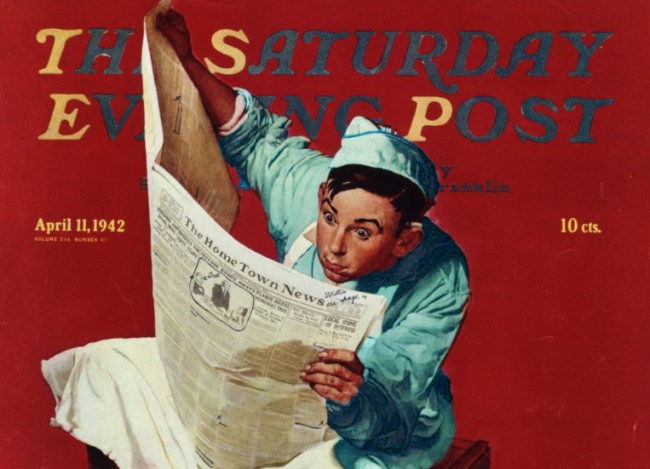
Understanding Military Terminology - National Communications System
(DOD) The telecommunications system that results from the technical and operational integration of the separate telecommunications systems of the several executive branch departments and agencies having a significant telecommunications capability. Also called NCS.
Joint Publications (JP 6-0) Joint Communications System - Joint Chiefs of Staff

The Old Salt’s Corner
“Sea Dreams” (Part II)
“Forgive! How many will say, “forgive”, and find
A sort of absolution in the sound
To hate a little longer! No; the sin
That neither God nor man can well forgive,
Hypocrisy, I saw it in him at once.
Is it so true that second thoughts are best?
Not first, and third, which are a riper first?
Too ripe, too late! they come too late for use.
Ah love, there surely lives in man and beast
Something divine to warn them of their foes:
And such a sense, when first I fronted him,
Said, “trust him not;” but after, when I came
To know him more, I lost it, knew him less;
Fought with what seem'd my own uncharity;
Sat at his table; drank his costly wines;
Made more and more allowance for his talk;
Went further, fool! and trusted him with all,
All my poor scrapings from a dozen years
Of dust and deskwork: there is no such mine,
None; but a gulf of ruin, swallowing gold,
Not making.
Ruin'd! ruin'd! the sea roars
Ruin: a fearful night!”
“Not fearful; fair,”
Said the good wife, “if every star in heaven
Can make it fair: you do but bear the tide.
Had you ill dreams?”
“O yes,” he said, “I dream'd
Of such a tide swelling toward the land,
And I from out the boundless outer deep
Swept with it to the shore, and enter'd one
Of those dark caves that run beneath the cliffs.
I thought the motion of the boundless deep
Bore through the cave, and I was heaved upon it
In darkness: then I saw one lovely star
Larger and larger.
“What a world”, I thought,
“To live in!” but in moving I found
Only the landward exit of the cave,
Bright with the sun upon the stream beyond:
And near the light a giant woman sat,
All over earthy, like a piece of earth,
A pickaxe in her hand: then out I slipt
Into a land all of sun and blossom, trees
As high as heaven, and every bird that sings:
And here the night-light flickering in my eyes
Awoke me.”
“That was then your dream,” she said,
“Not sad, but sweet.”
~ Alfred, Lord Tennyson (Part II of VI)
Full Poem

“I’m Just Sayin”
“Nothing haunts us like the things we don’t say.”
“Death ends a life,
not a relationship.”
“Each affects the other,
and the other affects the next,
and the world is full of stories,
but the stories are all one.”
~ Mitch Albom

“Thought for the Day”
“Be the flame, not the moth.”
“If you have not done things worthy of being written about,
at least write things worthy of being read.”
“I have always loved truth so passionately
that I have often resorted to lying
as a way of introducing it into the minds
which were ignorant of its charms.”
~ Giacomo Casanova

“What I Learned”
“The first victim of anger is the angry one.”
“The First Impression Is Not The Last Impression,
But A Lasting Impression.”
“The glass is neither half-full nor half-empty;
the glass is twice as big as it should be.”
~ Anonymous

Second Hand News (Links to Articles from Week 30 - July 29, 2019 - August 04, 2019)
 'Hate has no place in our country': Trump responds to mass shootings
• El Paso suspect reportedly wrote four-page racist, anti-immigrant manifesto before attack
• Hero soldier ran towards El Paso gunfire to save children
• Nine people shot dead in Dayton, Ohio
• Suspect in custody after 20 people killed in El Paso Walmart shooting
• Kamala Harris willing to send cops to people's homes to confiscate banned firearms
'Hate has no place in our country': Trump responds to mass shootings
• El Paso suspect reportedly wrote four-page racist, anti-immigrant manifesto before attack
• Hero soldier ran towards El Paso gunfire to save children
• Nine people shot dead in Dayton, Ohio
• Suspect in custody after 20 people killed in El Paso Walmart shooting
• Kamala Harris willing to send cops to people's homes to confiscate banned firearms
America’s second-deadliest weekend: El Paso and Dayton death toll reaches 29
• Mexico to take legal action against US after three Mexican nationals die in El Paso shooting
• 2020 Democrats agree: Trump is responsible for El Paso shooting
• Prosecutors treating El Paso as domestic terrorism and will seek death penalty
• Body of 17-year-old Marine brought home 75 years after his death in the Battle of Tarawa
Editor's Picks:
Michael Savage asks new United Kingdom Prime Minister Boris Johnson to lift 10-year ban on him
• Gillette CEO: $8 billion loss is 'price worth paying' over #MeToo campaign
• Business groups warn new Trump China tariffs threat hurts planning
• Ilhan Omar: Pelosi sent me back to Africa and tagged along for the ride
Commentary - Washington Secrets - Red Alert:
Ronald Reagan and Pope John Paul II showed how Catholics and Protestants can unite
• Fighter crash reminds us our troops are always in danger
• Trump must challenge China over Hong Kong
Washington Examiner
 Trump blames shootings on mental illness in first public statements since two mass shootings over the weekend and pledges more action will come in an announcement Monday
• Gunman dressed all in black and wearing body armor opens fire on patrons at a small Dayton, Ohio bar, killing 9 and injuring 16 within ONE MINUTE in America's second mass shooting in just 14 hours
Trump blames shootings on mental illness in first public statements since two mass shootings over the weekend and pledges more action will come in an announcement Monday
• Gunman dressed all in black and wearing body armor opens fire on patrons at a small Dayton, Ohio bar, killing 9 and injuring 16 within ONE MINUTE in America's second mass shooting in just 14 hours
El Paso Walmart shooter Patrick posted twisted anti-Mexican manifesto online 20 minutes before storming store with an AK-47, killing 20 people
• Army veteran is hailed a hero after braving gunfire during El Paso Walmart massacre to carry screaming children to safety
• Fox News correspondent struggles with emotion as he retells 'horrific' moment survivor said he found his mother dead after shooter opened fire at an El Paso Walmart
• Missing four-year-old girl is discovered 1,200 miles from home during human trafficking raid on a Texas property - and authorities believe her own MOTHER 'handed her over to the group's pimp'
• Florida McDonald's worker is fired after she refused to serve two paramedics thinking they were police officers, telling them 'we don't serve your kind here' or 'anyone with a badge'
Daily Mail UK
 Iran seizes 'foreign' vessel in Persian Gulf
• Hong Kong police arrest 20 people after protests
• Ohio hit by mass shooting hours after El Paso attack
• United States: 'Many killed' in El Paso mall shooting
• German police say 71 officers injured during deportations
Iran seizes 'foreign' vessel in Persian Gulf
• Hong Kong police arrest 20 people after protests
• Ohio hit by mass shooting hours after El Paso attack
• United States: 'Many killed' in El Paso mall shooting
• German police say 71 officers injured during deportations
Nantes police clash with protesters after festivalgoer's death
• Malta grants entry to German Sea-Eye boat with 40 migrants
• Mexico: 3 journalists killed in one week
• Syria air base blast kills dozens of regime fighters: monitor
• In Germany, states roll out stun guns despite risks
French inventor crosses English Channel on 'Flyboard'
• China denies entry to German Greens party
• Khmer Rouge 'brother number 2' Nuon Chea serving a life sentence for genocide and crimes against humanity dies
• Germany pursues justice for survivors of Yazidi genocide
• Amsterdam: Men occupy brothel windows in red light district
Deutsche Welle
 Hong Kong police fire rounds of tear gas in Causeway Bay shopping hub
• Hundreds attack police station after Tseung Kwan O march turns ugly
• Beijing condemns Hong Kong protesters who threw flag in the sea
• More than 20 arrested in Hong Kong after clashes in Kowloon
• Beijing is using Chinese tourists to inflict economic pain - but does it work?
Hong Kong police fire rounds of tear gas in Causeway Bay shopping hub
• Hundreds attack police station after Tseung Kwan O march turns ugly
• Beijing condemns Hong Kong protesters who threw flag in the sea
• More than 20 arrested in Hong Kong after clashes in Kowloon
• Beijing is using Chinese tourists to inflict economic pain - but does it work?
North Korea Nuclear Crisis: Kim Jong-un won’t ‘disappoint me’ despite missile tests, Trump says / North Korea conducts third recent missile launch but Trump says ‘no problem’
MORE TOP STORIES
China hits back at Trump’s fentanyl claim, calling it ‘blatant slander’
• Residents turn on Hong Kong police for using tear gas as protests rage
• Hong Kong braces as 14,000 expected to join biggest strike in decades
• Thousands rally in support of Hong Kong’s embattled police force
• Censors say patriotic shows must mark republic’s 70th anniversary
Opinion:
Kim Jong-un’s strategy suggests U.S. has a choice: change stance, or talks will go nowhere
• How is Hong Kong’s property market affected by the protest crisis and how much can youth anger be linked to home ownership?
• Conundrum for government as civil servants take a stand
South China Morning Post

Mr. Answer Man Please Tell Us: If the Moon is Gradually Moving Farther Away From Us, Will Its Gravitational Pull Ever Cease on Earth?
The Moon is receding from the Earth, but will not continue to do so forever. We have to consider why the Moon is moving away at around 1.5 inches (3.78 cm) per year - a force is necessary to cause that.
The Moon exerts a tidal force on the Earth, causing a bulge. But, because the Earth rotates, that bulge is not directly between the Earth and Moon. It is slightly in front. That bulge has a gravitational pull on the Moon, causing it to move forward, slightly faster.
Causing the Moon to move slightly faster results in it climbing very slowly to a higher orbit. The Moon climbs higher by about 3.78 cm per year. But, since we just said that the force is gravitational and we know that gravity decreases with distance, we know that the force will also decrease with distance.
That means the rate at which the Moon recedes will decrease with time. But there's more to it than that. A force acts upon both bodies. While the impact on the Moon is causing it to recede, the impact on the Earth is that it is being caused to slow its rotation. The day is getting longer.

Eventually, the length of the day will match the orbital period of the Moon. That means both bodies will be tidally locked - meaning the same part of the Earth will always face the same part of the Moon. And if that happens, there is no longer a leading bulge and thus no longer a force causing the Moon to move away.
This would happen when the orbital period of the Moon is about 47 days. That would put the Moon at a distance of about 550,000 km; less than half as far again as it is today. In other words, not very far.
However, it will take a long time for that to happen. In the meantime, the Sun will turn into a red giant and its outer layers will extend to where Mars is today, meaning Earth, the Moon, and every In-N-Out restaurant will have been swallowed up and turned into loose atoms.
Aerospaceweb.org
• Arxiv.org
• BBC
• NASA
• Quora
• Wikipedia
/ If the Moon is Gradually Moving Farther Away From Us, Will Its Gravitational Pull Ever Cease on Earth? (YouTube) 

NAVSPEAK aka U.S. Navy Slang
FAG:
1. Fighter Attack Guy: F/A-18 Hornet/Super Hornet pilot or naval flight officer (“NFO”).
2. Former Action Guy: Any SO, SB, EOD, ND, or FMF Recon Corpsman or any other parachute-qualified member who is in a position where they cannot maintain their jump quals, or goes into a different warfare community.
3. (“Submarine Service”) Forward Area Gentleman: A crewman serving in the forward part of the submarine, a non-Nuke.
Family Gram: A 40-word personal communication from the family members of an Officer or Sailor on a Strategic Deterrent Patrol assigned to a Fleet Ballistic Missile (FBM) submarine. Each crewman was allocated a limited number of these messages during each 3-month patrol and they were severely censored to protect the submariner from news that could negatively effect the emotional condition of the recipient. All Family Grams were screened by the CO/XO upon receipt, prior to distribution to the individual. A similar system was used for surface ships.
Fan Room (see “X-Ray fitting”): A room with a fan or blower, A “closed” space which is often utilized for general mischief away from watchful eyes.
F.A.W.C.U. (pronounced “fuck you”) (Submarine Service): Ability to see but not interact with something pleasurable, especially members of the opposite sex; For example, male sailors may joke that they have eyeball liberty ogling a boat full of women while exiting port, or in view a port itself where no actual liberty is allowed.
Fart sack: Canvas mattress cover (In cold conditions sailors sleep inside them for extra warmth.) or a dirt sailor's sleeping bag.
Fart Suit: Dry suit worn by aviators when flying over cold water. So called because of the rubber seals at the neck and wrists which keep water out in the event of water entry. These seals also keep all flatulence inside the suit, where it remains hot and mixes with ball sweat, pitstink, and various other foulness. This foul air is released by removing the suit, or more amusingly by pulling one of the wrist seals open while squatting and pointing at an unsuspecting individual, thus forcing all the stench in his direction.
Farting dust: Getting old.
Wiktionary.org

Just for you MARINE
Fallen Angel: Marine Officer who failed out of flight school and is now in another MOS.
FAP: Fleet Assistance Program, a program designed to assign Marines to extra duties outside his or her normal chain of command. Long seen as a means for commands to “reassign” their lowest-performing or misbehaving Marines.
FARP: Forward Area Refueling/Rearming Point or Forward Arming Refueling Point, a space on the battlefield designated for the re-arming and re-fueling of aircraft.
Fart Sack: Cotton mattress cover; large sack made of linen that a mattress is inserted into. Serves as a military form of a fitted sheet.
Wikipedia.org

Naval Aviation Squadron Nicknames
VT-6 Training Squadron Six (VT-6) TRARON SIX - nicknamed the “Shooters”
United States Navy - Naval Air Station Whiting Field, Milton, Florida - Naval Air Station Corpus Christi, Texas - Established May 1, 1960.

Where Did That Saying Come From?

“There's no such thing as a free lunch:”
Meaning: The economic theory, and also the lay opinion, that whatever goods and services are provided, they must be paid for by someone - that is, you don't get something for nothing. The phrase is also known by the acronym of 'there ain't no such thing as a free lunch'.
History: Free lunch was a commonplace term in the USA and, to a lesser extent in Britain, from the mid 19th century onward. It wasn't used to describe handouts of food to the poor and hungry though, it denoted the free food that American saloon keepers used to attract drinkers; for example, this advertisement for a Milwaukee saloon, in The Commercial Advertiser, June 1850:
“At The Crescent...
Can be found the choicest of Segars, Wines and Liquors...
N. B. - A free lunch every day at 11 o'clock will be served up.”
Free lunches, often cold food but sometimes quite elaborate affairs, were provided for anyone who bought drink. This inducement wasn't popular with the temperance lobby and was also criticized for the same reason that others in the 20th century later introduced the TANSTAAFL idea to economic thinking, that is, saloon customers always ended up paying for the food in the price of the drinks they were obliged to consume. Indeed, some saloon keepers were prosecuted for false advertising of free lunch as customers couldn't partake of it without first paying money to the saloon.
It was into this context that the economic theorists enter the fray and 'there's no such thing as a free lunch' is coined. It isn't known who coined the phrase. It certainly wasn't the economist Milton Friedman, who was much associated with the term. He was a celebrated Nobel Prize-winning economist and his monetarist theories were highly influential on the Reagan and Thatcher administrations in the 1980s and 90s. Friedman certainly believed that 'there's no such thing as a free lunch' and he published a book with that title in 1975, but wasn't, and never claimed to be, the originator of the phrase.
The phrase appears to have come about in response to the libertarian views of Henry Wallace, the US Vice President between 1941 and 1945. He wrote an article which was originally published by The Atlantic Monthly in which he suggested a post-WWII worldwide economic regime offering "minimum standards of food, clothing and shelter" for people throughout the world and offering the opinion that "If we can afford tremendous sums of money to win the war, we can afford to invest whatever amount it takes to win the peace". Paul Mallon, a Washington journalist, responded to Wallace's article with a critical piece, published in several US papers, including The Lima News, January 1942:
“Mr. Wallace neglects the fact that such a thing as a 'free' lunch never existed. Until man acquires the power of creation, someone will always have to pay for a free lunch.”
The first record I can find of the precise phrase there's no such thing as a free lunch, comes following year, in an editorial in The Long Beach Independent, October 1943, again referring to Wallace:
Some people say there is no such thing as a free lunch, but you listen to a fireside chat from Washington, and the voice will tell you all about it, and how you can make something for nothing.
The 'there ain't no such thing as a free lunch' version of the phrase is often reduced to the acronym TANSTAAFL. This is widely associated with the science fiction writer Robert Heinlein. he did used the term several times in his 1966 novel The Moon is a Harsh Mistress, but the coinage of the acronym pre-dates that by at least a quarter of a century. The earliest citation I can find for tanstaafl is from October 1949, when it appeared in a book review published in several US newspapers, including The Independent Record:
“Now, our secret: Tanstaafl is mnemonic for "there ain't no such thing as a free lunch.”
Phrases.org UK

Science & Technology

Researchers find that the sun's magnetic field is ten times stronger than previously believed
• New species of mastodon discovered in California
• Using an organocatalyst to stereocontrol polymerization
• The first complete mapping of cerebral functional lateralisation
• Fossils show recovery from extinction event helped shape evolutionary history
• Fluorescence discovered in tiny Brazilian frogs
• Major step towards individual cancer immunotherapy
Phys.org / MedicalXpress / TechXplore

Bizarre News (we couldn’t make up stuff this good – real news story)
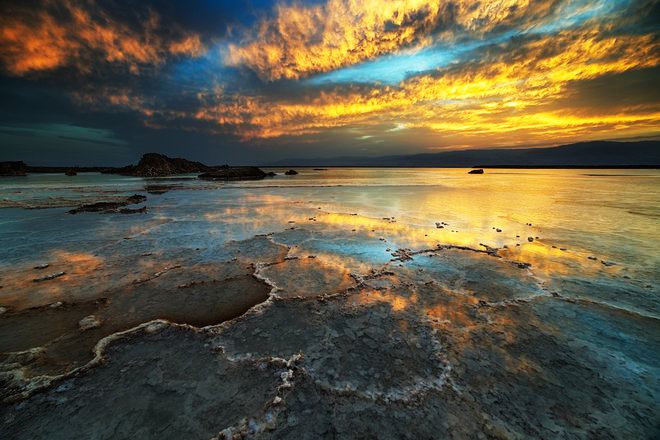
Ancient Microbes Ate Each Other's Corpses to Survive Beneath the Dead Sea
On its salty surface, the Dead Sea is famous for making giddy tourists float like beach balls. Hundreds of feet below the water, however, life is a little less fun.
There, choked by some of the saltiest water on Earth, single-celled microorganisms called archaea struggle to carry out life's basic functions without oxygen, light or fresh forms of sustenance. According to a new study published March 22 in the journal Geology (Geo Science World), the survival of microbial life beneath the Dead Sea may have once even depended on eating the dead. [The 10 Strangest Places Where Life Is Found on Earth]
In their study, researchers from Switzerland and France analyzed long sediment cores drilled out of the center of the Dead Sea, and found evidence that ancient microbial life accumulated the energy it needed to survive by gobbling up bits of dead neighbors that couldn't hack the harsh conditions.
According to the researchers, these results open a window into Earth's mysterious deep biosphere - the subterranean world between Earth's surface and its core - where potentially millions of undiscovered microbial species thrive in improbably extreme conditions.
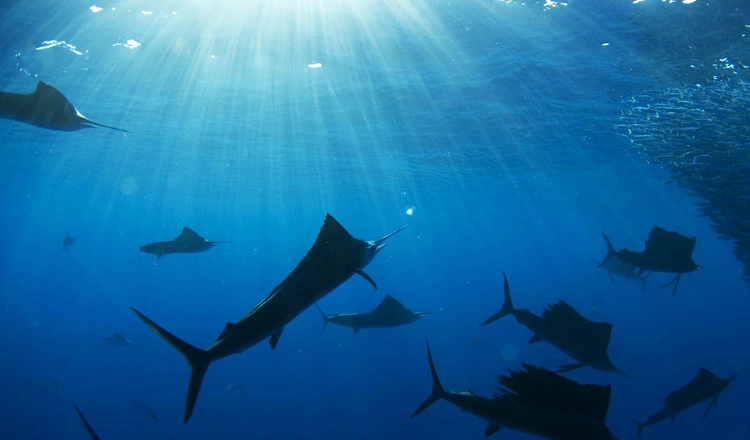
“The Dead Sea's subsurface environment constitutes one of the most extreme ecosystems on the planet”, the authors wrote in their paper. “By studying an environment that pushes life to its limits, we catch a glimpse of the processes that fuel life in the deep subsurface.”
Dead in the water
The Dead Sea (which is not really a sea, but a salt lake straddling the borders of Israel, Jordan and Palestine) begins about 1,400 feet (430 meters) below sea level, making it the single lowest place on land. The lake is also one of the saltiest: its waters are nearly 10 times saltier than the world's oceans, giving only the most salt-loving archaea a fair shot at survival.
To better understand the microbial history of this extreme ecosystem, the study authors investigated ancient sediment samples buried up to 800 feet (245 m) below the lake's surface. Inside these deep slices of lakebed, the team found traces of long-dead microbial life.
In the saltiest layers of the lake's underbelly, the team found lots of microbial compounds called wax esters - a type of energy-storage molecule that the world's smallest organisms can create when their survival is pushed to the limits. Think of it as a tiny carbon refrigerator - but, in order to turn it on, an organism needs to gobble up some of the fatty bits left behind by dead microbes that couldn't survive their harsh habitats.
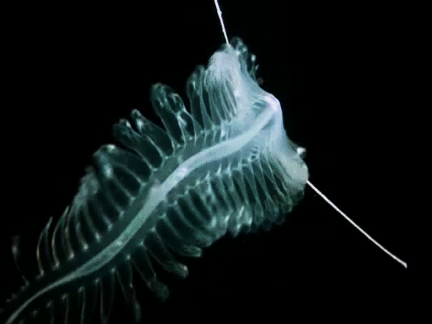
Bacteria have been known to turn bits of their dead neighbors into wax esters before, but archaea don't seem to have this skill, the authors wrote. So, the team concluded, the wax esters found deep below the Dead Sea probably came from rough-and-tumble bacteria that had no choice but to feed on the corpses of dead archaea in order to survive their super-salty environment.
This is surprising, as bacteria were previously thought to be incapable of adapting to the lake's extreme ecosystem. However, by “recycling” bits of better-adapted microbes, that survival may have been possible in the past, the authors wrote. This may not only be true for the Dead Sea ecosystem, but could also apply to other severe environments scattered throughout the planet's vast underground biosphere.
“Our results illustrate the high adaptability of the subsurface biosphere and its ability to use varied strategies for energy production and preservation under adverse conditions”, the authors concluded.
In other words, the Dead Sea might not be as dead as you thought.
• The 10 Driest Places on Earth
• The 8 Hottest Places on Earth
• Microscopic Monsters: Ugly Bugs Under the Microscope
Live Science (03/26/2019) 


SONG FACTS
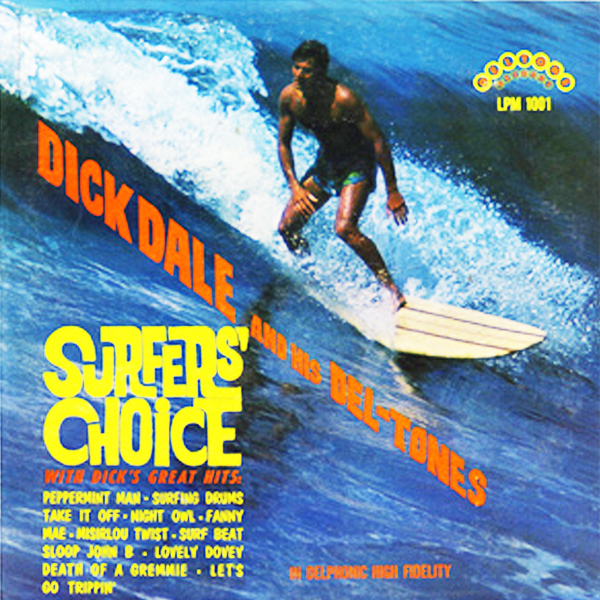
“Miserlou” - Dick Dale
Album: Surfers' Choice
Released 1962 
“Miserlou” (sometimes rendered “Misirlou”) is a traditional Mediterranean song dating to the 1920s and originating in Greece. It was la The word roughly translates to “Arab Land”. Dick Dale reworked the song using his trademark Surf Rock sound, and this became the version of the song that caught on in America. It was released as a single on the Del-Tone label in 1962, and later that year as “Miserlou Twist” on his first album Surfers' Choice. As Surf Rock caught on, the song was recorded by The Beach Boys, The Ventures, The Surfaris, The_Bobby_Fuller_Four and just about anyone looking for the young California sound.
Richard Monsour, May 4, 1937, Boston, Massachusetts, USA. (Note: Dale himself has been quoted in interviews as saying he was born in Beirut, Lebanon, and that his family emigrated to Quincy, Massachusetts, when he was a child. Now, however Dale denies that story and claims to have been born in Boston.) Dale is usually credited as the inventor of the instrumental surf music style and the major influence on surf guitar. With his band The Del-Tones, Dale’s early 60s records sparked the surf music craze on the U.S. west coast, and his guitar-playing influenced hundreds of other musicians.
Dale started out as a pianist at the age of nine, and also played trumpet and harmonica, before switching to the ukulele and then finally guitar. His first musical interest was country music and his idol was Hank Williams. Dale’s family moved to El Segundo, California in 1954 and he took a job at an aircraft company after graduating from high school. Having learned country guitar, he entered talent contests, still performing under his real name. The name Dick Dale was suggested to him by a Texas disc jockey named T. Texas Tiny. Dale gained popularity as a local country singer and also appeared in concerts with rhythm and blues artists. He also gained a small role in a Marilyn Monroe movie, Let’s Make Love.
Dale’s first record was “Ooh-Whee-Marie”  on the Deltone label, which his father owned. He eventually recorded nine singles for Deltone between 1959 and 1962, and also recorded for the Cupid label. One of those Deltone singles, “Let’s Go Trippin'”
on the Deltone label, which his father owned. He eventually recorded nine singles for Deltone between 1959 and 1962, and also recorded for the Cupid label. One of those Deltone singles, “Let’s Go Trippin'”  , released in 1961, is generally considered to be the first instrumental surf record. According to Dale, he and his cousin were riding motorcycles to the beach on the Balboa Peninsula in southern California, where Dale befriended the local surfers. There he also began playing with a band at a club called the Rinky Dink.
, released in 1961, is generally considered to be the first instrumental surf record. According to Dale, he and his cousin were riding motorcycles to the beach on the Balboa Peninsula in southern California, where Dale befriended the local surfers. There he also began playing with a band at a club called the Rinky Dink.
Another guitar player showed him how to make certain adjustments to the pickup settings on his Stratocaster guitar to create different sounds, and that sound, aided by other sonic developments and featuring Dale’s staccato attack, became his trademark. Although he was still playing country music, he moved closer to the beach and began surfing during the day and playing music at night, adding rock ‘n’ roll to his repertoire.
By then Dale had formed his own band, the Del-Tones, including piano, guitars, bass, drums and saxophone, and shifted his home base to the Rendezvous Ballroom down the beach from the Rinky Dink. The band, like most others, performed vocal compositions, until one patron asked Dale if they could play an instrumental song. Inspired by his surfing hobby, Dale composed a tune that he felt captured the feeling of riding the waves and the power of the ocean. Once the band began adding more instrumental songs in this style to its repertoire, the crowd grew in size until the Rendezvous was packed to capacity. At one point city officials tried to run Dale out of town, believing that his music was having a negative effect on the local youth.
Playing left-handed without reversing the strings, Dale started to fine-tune the surf guitar style. He met with Leo Fender, the inventor of the Fender guitar and amplifier line, and worked with him on designing equipment that would be more suited to that style of music (Dale helped to develop the popular Showman amp). Along with other innovations, such as the first outboard reverb unit, which helped define the surf sound, the JBL speaker and the Rhodes piano, Dale was able virtually to reinvent this new style of rock ‘n’ roll as he went along. “Let’s Go Trippin'”  was the first instrumental recording by Dale, and one of only two singles to make the U.S. national charts (at number 60, based entirely on local sales in California), with “Shake ‘N’ Stomp”
was the first instrumental recording by Dale, and one of only two singles to make the U.S. national charts (at number 60, based entirely on local sales in California), with “Shake ‘N’ Stomp”  and “Misirlou”
and “Misirlou”  (a rewrite of a traditional Greek song written by Nicholas Roubanis) also popular early Dale singles on Deltone.
(a rewrite of a traditional Greek song written by Nicholas Roubanis) also popular early Dale singles on Deltone.
Dale released his first album, Surfer’s Choice, also on Deltone, in 1962. Recorded live, it was one of the first albums to feature a surfer (Dale) on the cover. (At the same time, vocal surf music, as pioneered by The Beach Boys, began to take off, but the two styles had little in common musically. Moreover Dale’s first recording preceded theirs by two months.) The instrumental surf music craze was initially largely confined to the Orange County area, but its popularity there became so overwhelming that Los Angeles radio stations began playing the music of Dale and the other new surf bands. In 1963, after Surfers’ Choice made the national album charts (number 59), Capitol Records signed Dale to a seven-album contract (only five were released).
One of Dale’s singles for Capitol, “The Scavenger”  , made the U.S. charts, as did the Checkered Flag album that year, but Dale never charted again, remaining almost entirely a local phenomenon while becoming a major influence on other musicians. Dale appeared on The Ed Sullivan Show
, made the U.S. charts, as did the Checkered Flag album that year, but Dale never charted again, remaining almost entirely a local phenomenon while becoming a major influence on other musicians. Dale appeared on The Ed Sullivan Show  on U.S. television and received national press coverage, but his reluctance to travel, combined with the brief popularity of surf music, hindered his career advancement. He appeared in the 1964 movie Muscle Beach Party but that same year, with the arrival of the British beat bands, Capitol had shifted its priorities and Dale was dropped from the label less than two years after signing to it.
on U.S. television and received national press coverage, but his reluctance to travel, combined with the brief popularity of surf music, hindered his career advancement. He appeared in the 1964 movie Muscle Beach Party but that same year, with the arrival of the British beat bands, Capitol had shifted its priorities and Dale was dropped from the label less than two years after signing to it.
Dale continued to record sporadically throughout the rest of the 60s and 70s for numerous labels but a cancer scare, which he overcame, effectively sidelined his career. His music was rediscovered in the 80s, and he recorded a scorching duet with Stevie Ray Vaughan of the old Chantays surf instrumental “Pipeline”  in 1987 for the movie Back To The Beach. In 1989, Rhino Records released a compilation of Dale’s best recordings, and in the early 90s Dale signed with the U.S. label HighTone Records. His 1993 album Tribal Thunder and the 1994 follow-up, Unknown Territory, as well as numerous live gigs across the USA, have showed that Dale’s influence remains strong and that his powers as a musician, although limited, are undiminished. In 1994, his recording of ‘Misirlou’ was prominently featured in the Quentin Tarantino movie Pulp Fiction, bringing Dale new recognition to a much younger audience. This resulted in Dale being able to trade on the word ‘legendary’ wherever he went and launching a revitalized recording career.
in 1987 for the movie Back To The Beach. In 1989, Rhino Records released a compilation of Dale’s best recordings, and in the early 90s Dale signed with the U.S. label HighTone Records. His 1993 album Tribal Thunder and the 1994 follow-up, Unknown Territory, as well as numerous live gigs across the USA, have showed that Dale’s influence remains strong and that his powers as a musician, although limited, are undiminished. In 1994, his recording of ‘Misirlou’ was prominently featured in the Quentin Tarantino movie Pulp Fiction, bringing Dale new recognition to a much younger audience. This resulted in Dale being able to trade on the word ‘legendary’ wherever he went and launching a revitalized recording career.
Dick Dale, official website / Oldies / Billboard / All Music / Song Facts / Ultimate Classic Rock / Cleveland.com (Rock & Roll Hall Of Fame) / Dick Dale
Image: “Surfers' Choice (album)” by Dick Dale 

Trivia
● Beethoven's Piano Sonata in C Minor and Tchaikowski's Symphony Number 6 both have the same sad-sounding name. What is this one word?
Answer to Trivia
● Give the full names of those types of electric current known as AC and DC.
Answer to Trivia
● What kind of tableware is named for a country?
Answer to Trivia
● The era of modern technology was launched in the early 1940's when the first electronic computer, weighing 30 tons and using 17,000 vacuum tubes, was built at the University of Pennsylvania. What was the five letter name of this first computer?
Answer to Trivia

A Test for People Who Know Everything
From the Jeopardy Archives Category - “BACK IN BLACK” ($200)
“A slump in comic book sales drove it into bankruptcy in 1996; since then its cinematic universe alone has raked in $10 billion.”
● Answer for People Who Do Not Know Everything, or Want to Verify Their Answer Screen Crush
From the Jeopardy Archives Category - “BACK IN BLACK” ($400)
“On the verge of going bust in 1997, it was saved by a $150 million investment by rival Microsoft.”
● Answer for People Who Do Not Know Everything, or Want to Verify Their Answer CNBC
From the Jeopardy Archives Category - “BACK IN BLACK” ($1,000)
“U.S. taxpayers ponied up $180 billion to rescue this 3-letter insurance co., but got it all back, plus a profit.”
● Answer for People Who Do Not Know Everything, or Want to Verify Their Answer Investopedia
Answer to Last Week's Test
From the Jeopardy Archives Category - “ADULT BEVERAGES” ($200)
“In names of cocktails, this liquor precedes mockingbird & sunrise.”
● Answer: An Executor. Esquire
From the Jeopardy Archives Category - “ADULT BEVERAGES” ($400)
“The main ingredients in a mint julep are mint leaves, sugar syrup & this liquor.”
● Answer: The Beatitudes. Forbes
From the Jeopardy Archives Category - “ADULT BEVERAGES” ($1,000)
“They're the 2 main ingredients in a Cape Codder, one for adults & one for all ages.”
● Answer: A Musket. Berlys Kitchen

Joke of the Day
“Fear Under The Bed”

“Fear Under The Bed”
Ever since I was a child, I've always had a fear of someone under my bed at night.
So I went to a psychologist and told him: “I've got problems. Every time I go to bed I think there's somebody under it. I'm scared. I think I'm going crazy.”
“Just put yourself in my hands for one year”, said the psychologist.
“Come talk to me three times a week and we should be able to get rid of those fears.”
I asked, “How much do you charge?”
“One hundred fifty dollars per visit”, replied the doctor.
“I'll sleep on it”, I said.
Six months later the doctor met me on the street.
“Why didn't you come to see me about those fears you were having?” He asked.
“Well, $150 a visit, three times a week for a year, is $23,400.00.”
“A bartender cured me for $10.00.”
“I was so happy to have saved all that money that I went and bought a new pickup truck.”
“Is that so?” With a bit of an attitude he said, “and how, may I ask, did a bartender cure you?”
“He told me to cut the legs off the bed. Ain't nobody under there now.”
































